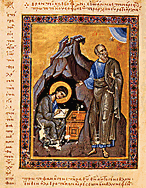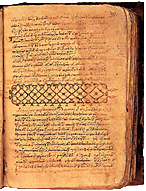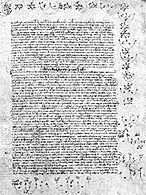 |
|
 |
Elementary, secondary and higher education.
 he education of children in the
he education of children in the
 Late Byzantine period was organised on the basic principles formulated in previous periods. Until they were six, children learnt their first letters at home at their mother's knee. After that, they went to school where they were taught the "holy letters", that is the alphabet, spelling, grammar and elementary arithmetic. The books the teachers used for the practice of these subjects were Christian texts, thus instruction assumed a rather religious character. This primary education took about 4 to 5 years. When they reached the age of eleven, only the sons of wealthy Late Byzantine period was organised on the basic principles formulated in previous periods. Until they were six, children learnt their first letters at home at their mother's knee. After that, they went to school where they were taught the "holy letters", that is the alphabet, spelling, grammar and elementary arithmetic. The books the teachers used for the practice of these subjects were Christian texts, thus instruction assumed a rather religious character. This primary education took about 4 to 5 years. When they reached the age of eleven, only the sons of wealthy
 families who lived in big cities had access to secondary education, the enkyklios paideia ("general education"). This comprised instruction in four
subjects (grammar, poetry, rhetoric and simple mathematics), this time on the basis of secular and not religious sources. This secondary education gave the boys the possibility to claim a position in the lower ranks of the state or church hierarchy. However, in order to attain the highest civil and ecclesiastical posts, further education was required, which was only families who lived in big cities had access to secondary education, the enkyklios paideia ("general education"). This comprised instruction in four
subjects (grammar, poetry, rhetoric and simple mathematics), this time on the basis of secular and not religious sources. This secondary education gave the boys the possibility to claim a position in the lower ranks of the state or church hierarchy. However, in order to attain the highest civil and ecclesiastical posts, further education was required, which was only
 provided in the capital and only by the imperial court and the Patriarchate respectively. Only the scions of eminent Byzantine families, the sons of superior officers and nephews or proteges of metropolitans, had access to further education. The emperor admitted them to his court and supervised their education by tutors. Education now demanded a more profound and serious study of poetry, rhetoric, medicine and philosophy, which was based on Aristoteles'
Organon.The
curriculum naturally included the study of advanced mathematics, which were called tetractys, since they consisted of four different subjects: arithmetic, astronomy, geometry and music. If a student aspired to the highest ecclesiastical offices, after completing these studies he would go on to specialise in theology. provided in the capital and only by the imperial court and the Patriarchate respectively. Only the scions of eminent Byzantine families, the sons of superior officers and nephews or proteges of metropolitans, had access to further education. The emperor admitted them to his court and supervised their education by tutors. Education now demanded a more profound and serious study of poetry, rhetoric, medicine and philosophy, which was based on Aristoteles'
Organon.The
curriculum naturally included the study of advanced mathematics, which were called tetractys, since they consisted of four different subjects: arithmetic, astronomy, geometry and music. If a student aspired to the highest ecclesiastical offices, after completing these studies he would go on to specialise in theology.
|